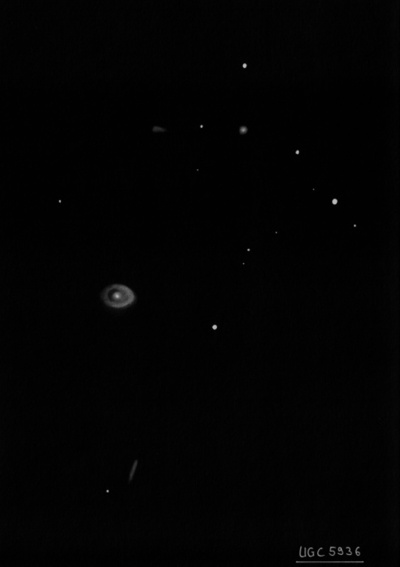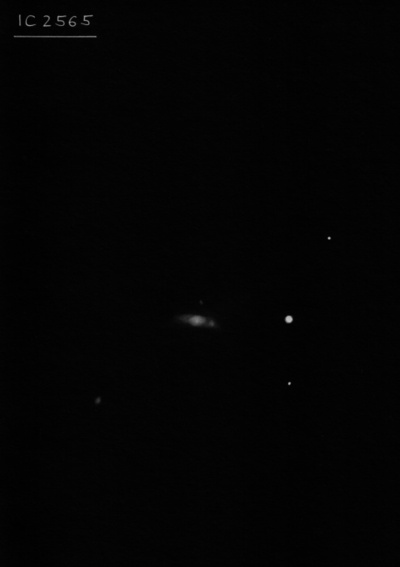A small and faint constellation of the northern sky that fills the space between the crescent of Leo to the south, Lynx to the west, and the hind legs of the Great Bear to the north and east. It is a faint, filler constellation with only seven stars brighter than 5mag. Only one star bears Bayer's designation - β Leo Minor, the others are designated by Flamsteed numbers. Apart from a few faint galaxies, the constellation contains no objects of interest. A few of them, mostly of 11th magnitude, can be seen in 200-250 mm binoculars as tiny nebulous clouds.
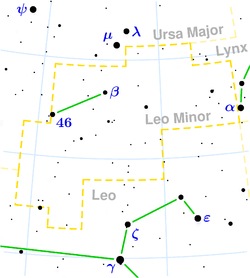
β LMi - The only star of the constellation that is assigned a Greek letter. This close binary star, which appears as a bright point of 4.2 magnitude to the naked eye, reveals its companion of 6.1 magnitude only in a large telescope and under good observing conditions. It is located at an angular distance of just a few tenths of a second. The orbital period of the components is 37 years and the distance is 145 light-years.
R LMi - The variable star of Mira type, similar in many ways to the permanently red R Leonis. Its period is about 372 days and its brightness varies from 6.3mag to 13.2mag, making it beyond the reach of small telescopes. It is located 45' southeast of the star 13 LMI, which has a brightness of 6.2mag.
NGC 3344
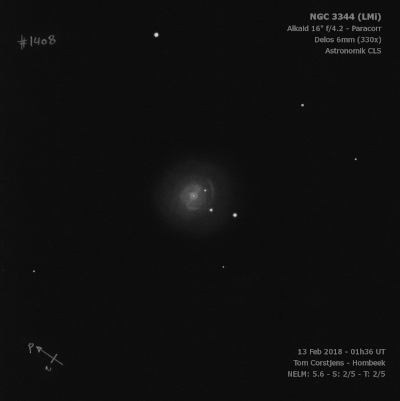
William Herschel discovered NGC 3344 = H I-81 = h739 on 6 Apr 1785 (sweep 393) and recorded "cB, cL, milky, very near and preceding 2 stars; a small part of the nebula is considerably brighter than the rest; the 2 stars and the brightest part of the nebula are all within 2' and nearly in one parallel. The greatest part of the milkiness is preceding the bright part, and the termination of it is imperceptible." He published a sketch in his 1811 paper (Fig. 2) as an illustration of "Nebulosities joined to Nebulae."
On 19 Feb 1827 (sweep 58), John Herschel logged, "pB; L; gbM; has (?) a star excentric within it and a double star closely following it." Bindon Stoney, observing on 3 Mar 1851, called it a "spiral, vF, has a branch from p edge round to n and f."
200/250mm - 8" (3/28/81): faint, large, low surface brightness. Two mag 10 stars are at the east edge.
400/500mm - 17.5" (1/19/91): fairly bright, large, about 4'x3' extended ~E-W. Unusual appearance as two bright stars are involved on the east side. Sharply concentrated with a faint outer halo and a well-defined much brighter core. A mag 10.5 star is on the east side 52" from the center and a mag 10 star is at the east edge of the halo 1.6' from the center. Also a mag 13.5 star is superimposed about 30" SSE of the core.
Notes by Steve Gottlieb
NGC 3504
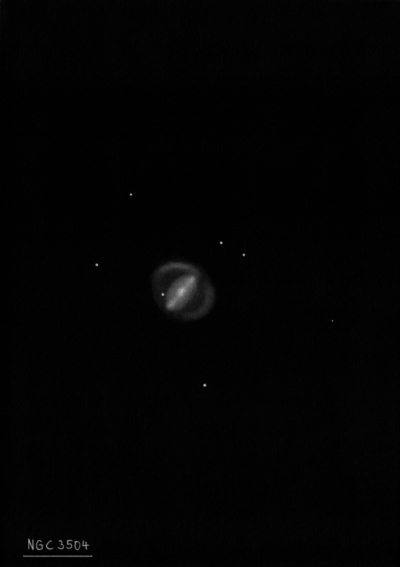
William Herschel discovered NGC 3504 = H I-88 = h810, along with NGC 3512, on 11 Apr 1785 (sweep 396) and noted "cB, cL, iR, bM." John Herschel made a total of 7 observations. R.J. Mitchell, observing at Birr Castle on 22 Feb 1857, recorded "mE, B nucl, arms faint, patchy,suspect dark space all around the nucleus." A month later he described "pL, Nucl vB and has a sensible disc, arms vF and patchy. I think I see a knot or patch in np end of neb."
The RA in the RNGC is 1.0 minute too large and the galaxy is misplotted on the first version of Uranometria 2000 (later fixed). Also see NGC 3506.
400/500mm - 17.5" (3/25/95): bright, large, elongated 2:1 NNW-SSE, 2.5'x1.2'. The [inner] halo has a fairly high irregular surface brightness. Sharp concentration with a very small well-defined core dominating. The bright core appears offset to the south side with the halo more extensive to the north. Two mag 14 stars lie 1.7' NNW (45" separation). First of three with NGC 3512 12' ENE and NGC 3515 24' NE.
Notes by Steve Gottlieb
NGC 2859
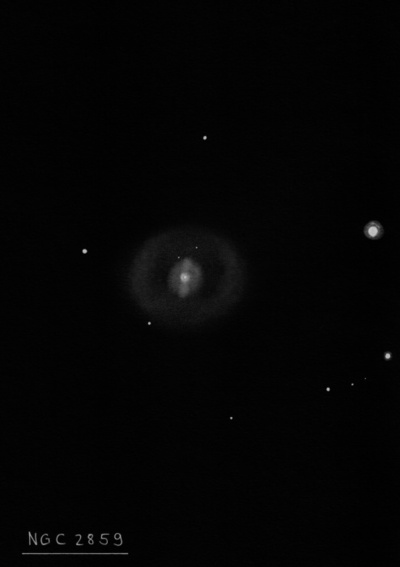
William Herschel discovered NGC 2859 = H I-137 = h593 on 28 Mar 1786 (sweep 549) and logged "vB, R, vsmbM, chevelure extending to about 3' diameter". John Herschel made 3 observations, recording on 1 Apr 1831 (sweep 336), "vB; R; vsmbM to a star; follows a * 7m and is 3' S of it." A total of 11 observations were made by LdR and assistants and a couple of superimposed stars were noted in the outer halo [on the north side]. On 28 Mar 1861, Sir Robert Ball wrote, "Dull Nucl, I susp a dark ring around it [there is!]. A vF neb nf. I strongly suspect st in h593 [=NGC 2859]." The "vF neb nf" is probably UGC 5004.
Originally classified as a SBa by Hubble. de Vaucouleurs (1975) lists it as one of the 5 brightest galaxies in the NGC 2964 group, which includes NGC 2859, 2964, 3003, 3032 and 3067.
200/250mm - 8" (12/6/80): faint, fairly small, round, bright core.
300/350mm - 13.1" (1/28/84): moderately bright, moderately large, strong concentration to a bright core, elongated 4:3 ~N-S, fainter halo. Located 40' ENE of Alpha Lyncis (V = 3.1).
Notes by Steve Gottlieb
NGC 3414
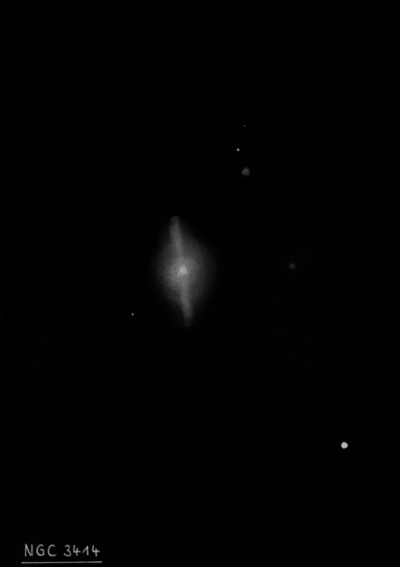
William Herschel discovered NGC 3414 = H II-362 = h773 on 11 Apr 1785 (sweep 396) and note "pB, pL." John Herschel made four observations (h773) while 8 observations were made at Birr Castle.
Bindon Stoney, using LdR's 72" on 6 Mar 1851, noted "Another neb eF, S. 2' np." Again on 23 Feb 1857 as well as 22 Mar 1857, R.J. Mitchell mentioned "about 1' np is vvF neb? lE." and "about 1.5' np [NGC 3414] there is a vvF patch of neby." These observations clearly refer to 2MASX J10511304+2800221 = PGC 93597, although it was not assigned a GC or NGC designation!
200/250mm - 8" (3/24/84): faint, slightly elongated.
300/350mm - 13.1" (3/24/84): bright, slightly elongated ~N-S, small bright nucleus, fairly small. Forms a pair with NGC 3418 8.5' NNE. Located 18' E of 44 Leonis (V = 5.6).
Notes by Steve Gottlieb
NGC 3432
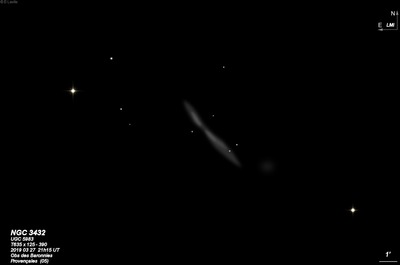
William Herschel discovered NGC 3432 = H I-172 = h780 on 19 Mar 1787 (sweep 719) and recorded "cB, about 2' long and 1/2' broad from sp to nf. In the preceding part a few stars pretty close together, and in the following part one, but unconnected." His position matches UGC 5986.
On 11 Mar 1831 (sweep 331), John Herschel recorded, "pB; vmE; 90" l, 12" br; pos = 44.2° It southern extremity touches the large star of a double star [at the south end]. Can this nebula have moved?" On 7 Feb 1832 (sweep 401), he logged "vF; a long ray pos = 40.8°; has a double star class 4 in middle, and one more." But the star at the east edge of the middle is only single. Rudolph Spitaler measured the position of a knot or HII region at the northeast end in an observation at Vienna in 1891.
Friedrich Bidschof measured two micrometric positions at the Vienna Observatory in Feb 1892 - one for the center or core and a second at a knot (HII complex) I mentioned in my notes.
400/500mm - 17.5" (3/25/95): fairly bright, large, edge-on 6:1 SW-NE, 3'x0.5. Irregular surface brightness and fainter on the southwest end. Appears to have a sharper light cut-off on the north side (due to dust?). A mag 12.5 star is 48" E of center and two mag 12/13 star are very close to the southwest tip 1.4' from center. The galaxy appeared asymmetric and brightest just north of the mag 12.5 star near the core [this corresponds to an HII complex]. A very weak enhancement [this is the core] is close west-southwest of this star.
Notes by Steve Gottlieb
NGC 3254
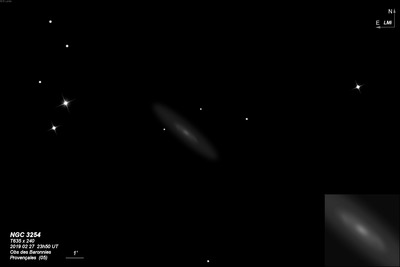
William Herschel discovered NGC 3254 = H I-72 = h714 on 13 Mar 1785 (sweep 386) and recorded "cB, cL, E, mbM. The brightness [core] also extended." His position is just off the west side of UGC 5685. John Herschel made a total of 3 observations. R.J. Mitchell noted "dark spaces suspected" in his 20 Mar 1854 observation at Birr Castle.
400/500mm - 17.5" (4/9/94): moderately bright, moderately large, edge-on 4:1 SW-NE, 3.0'x0.8', sharp concentration with small oval core surrounded by faint unconcentrated extensions, occasional very faint stellar nucleus. A mag 14 star is 2.9' W and a pair of mag 10 stars at 1.2' separation follows by 6'. Member of the NGC 3245 group (LGG 197)
Notes by Steve Gottlieb
NGC 3294
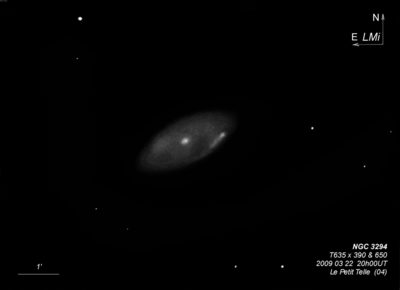
William Herschel discovered NGC 3294 = H I-164 = h724 on 17 Mar 1787 (sweep 713) and recorded "cB, E from 30° np to sf, 3 or 4' long and 1 1/2' br, easily resolvable, almost uniformly bright." Caroline's reduced position is 20 sec of RA east of UGC 5753. On 11 Mar 1831 (sweep 331), John Herschel noted, "pB; mE; glbM; 2' l, 45" br."
On 5 Mar 1851, LdR and Bindon Stoney recorded "an appendage at south side. LdR thought at times the nebula extended beyond this." The sketch shows a single spiral arm on the west side, curling clockwise to the south.
400/500mm - 17.5" (4/13/91): fairly bright, fairly large, elongated 5:2 NW-SE, large brighter core but no nucleus. A mag 14 star is 2.5' W and a mag 11 star 4.8' SSW. Located 5.5' WSW of mag 9 SAO 62151. NGC 3304 lies 18' NE.
Notes by Steve Gottlieb
NGC 3003
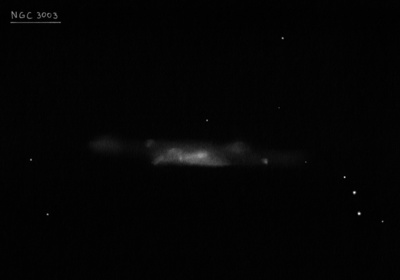
William Herschel discovered NGC 3003 = H V-26 = h639 on 7 Dec 1785 (sweep 487) and recorded "cB, mE nearly in the parallel, 8' long, 3' broad." His position is accurate. John Herschel described this object on 22 Jan 1828 (sweep 51) as "a singular curved wisp of nebula, It curls up and tapers off at the s p side, and is clubbed at the n f extremity."
A total of 13 observations were made at Birr Castle. On 8 Mar 1858, R.J. Mitchell commented "of unequal brightness throughout its length, p part is F but contains a B patch with a star in it; the foll part is comparatively much brighter and is mottled."
300/350mm - 13.1" (3/3/84): moderately bright, very elongated 7:2 WSW-ENE, 3.5'x1.0', almost even surface brightness.
600/800mm - 24" (4/20/14): bright, large, very elongated 4:1 WSW-ENE, 4.0'x1.0', mottled appearance, slightly bulging brighter core and nucleus, brighter and patchy along the major axis with a couple of very small knots. Nearly detached at the west end is a very low surface brightness patch that seems angled or extends beyond the major axis. A mag 15.7 star is ~1' N of center. NGC 3003 and NGC 3021, located 30' ENE, are the two brightest members in the USGC U268 group (z ~.005).
Notes by Steve Gottlieb
NGC 3158
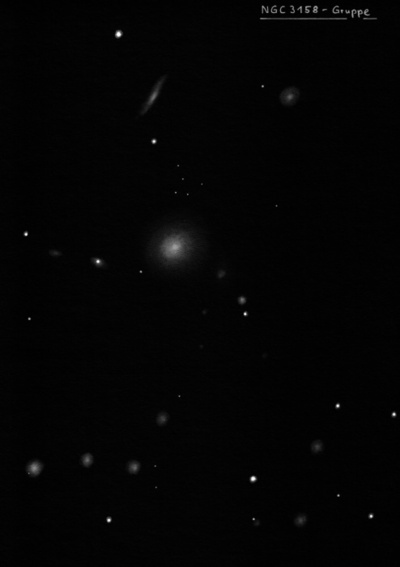
William Herschel discovered NGC 3158 = H II-639 = h678, along with NGC 3163, on 17 Mar 1787 (sweep 713) and noted "pB, cL, r." On 18 Mar 1831 (sweep 335), John Herschel logged, "B; R; psbM; 35 arc seconds."
200/250mm - 8" (3/28/81): faint, small, requires averted.
300/350mm - 13.1" (2/25/84): fairly bright, round, weakly concentrated, largest and brightest in a group.
400/500mm - 17.5" (3/23/85): fairly bright, irregular round or slightly elongated, small bright core. Brightest in the NGC 3158 group with NGC 3159 6.7' SSE, NGC 3160 4.7' N and NGC 3152 5.5' NW.
Notes by Steve Gottlieb
NGC 3395
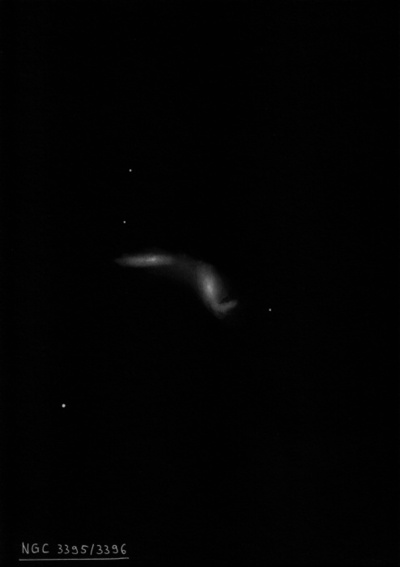
400/500mm - 17.5" (3/12/94): fairly bright, elongated 2:1 SSW-NNE, 1.5'x0.8', fairly high surface brightness, broadly concentrated halo, core appears rounder, no nucleus, mottled texture. This galaxy is slightly larger and brighter of a striking interacting pair, almost in contact with NGC 3396 at the NNE end 1.6' from center.
900/1200mm - 48" (5/4/16): this very bright, two-armed disrupted spiral forms an interacting, contact pair (Arp 270 = VV 246) with NGC 3396. At 375x, it contains a large bright core that increases to the center. On the north side of the core a spiral arm curls counterclockwise towards NGC 3396, nearly merging with the halo of the companion. A brighter, more defined spiral arm is on the south side; it rotates sharply counterclockwise nearly 180°, ending on the east side of the galaxy. A vague outer arm is at the south edge of the halo; it was visible as a low surface brightness extension to the southwest.
Notes by Steve Gottlieb
NGC 3510
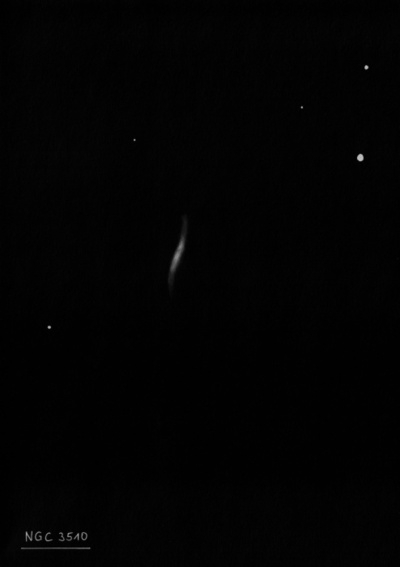
William Herschel discovered NGC 3510 = H II-365 = h813 on 11 Apr 1785 (sweep 396) and noted "F, mE, about 1 1/2' long but very narrow. On 24 Dec 1827 (sweep 115), John Herschel wrote, "pB; mE; nearly in meridian; bM." The assistants at Birr Castle made a total of 5 observations. For example, R.J. Mitchell, observing on 1 Mar 1854, noted "Query, an oval shaped spiral; major axis n-s."
300/350mm - 13.1" (3/24/84): faint, edge-on streak 4:1 NNW-SSE. Located 7.6' ESE of mag 7.3 SAO 81642 which interferes with viewing.
Notes by Steve Gottlieb
NGC 3424
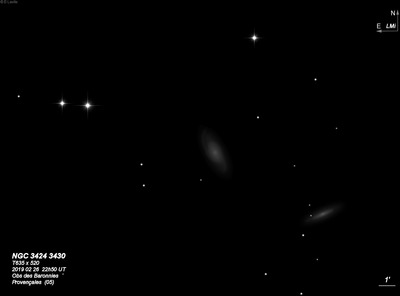
William Herschel discovered NGC 3424 = H II-494 = h778 on 7 Dec 1785 (sweep 487) and recorded "pB, pL, iR." Caroline's reduced position is 8 seconds of RA west of UGC 5972. On 6 Mar 1828 (sweep 128), John Herschel noted "B; E in a wisp; the sp of 2 [with NGC 3420].
400/500mm - 17.5" (4/9/94): moderately bright, moderately large, very elongated 3:1 WNW-ESE, 2.1'x0.7'. A mag 13.5 is superimposed at the east edge and a brighter mag 11.5 star is 1.4' SE of center. Forms a striking pair with NGC 3430 6.0' ENE.
Notes by Steve Gottlieb
NGC 3104
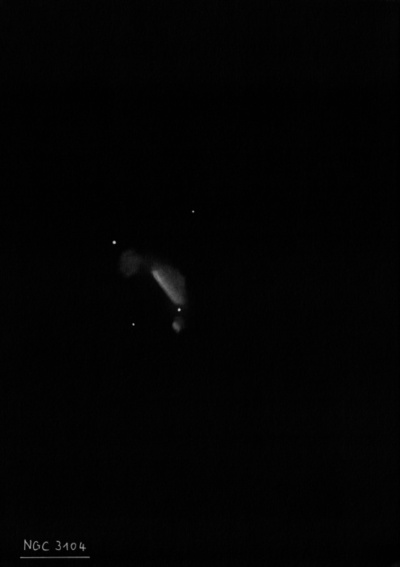
William Herschel discovered NGC 3104 = H IV-48 = h665 on 18 Mar 1787 (sweep 716) and logged "a vF star affected with vF nebulosity. E from sp to nf about 1' long. With 300 the same." Caroline's reduced position is 14 sec east of Arp 264. John Herschel wrote on 18 Mar 1831 (sweep 335), "A very small * seems to have a nebulous appendage, but moonlight troublesome."
400/500mm - 17.5" (4/18/98): faint, moderately large, ~1.5'-2' diameter although seems irregular in shape. Appears as a low but irregular surface brightness glow with a mag 13 star embedded at the south edge. Unusual appearance and could be mistaken for a reflection nebula around the star. With averted vision a fainter outer halo "grows" at times to 2.5' diameter nearly to a mag 14 star off the NE edge.
Notes by Steve Gottlieb
